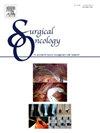Risk factors for postoperative evisceration after cytoreductive surgery and HIPEC. A comparative study of open and closed abdominal techniques
IF 2.4
4区 医学
Q3 ONCOLOGY
引用次数: 0
Abstract
Background
Standard treatment for resectable peritoneal metastasis (PM) includes the combination of cytoreductive surgery (CRS) and Hyperthermic Intraperitoneal Chemotherapy (HIPEC). Postoperative evisceration is a rare but major complication after CRS and HIPEC. This study aimed to identify the risk factors associated with evisceration after HIPEC, comparing outcomes between open and closed abdominal HIPEC.
Methods
We conducted a retrospective multi-center study analyzing data of 233 patients with PM who underwent CRS/HIPEC between 2014 and 2023. Patients were categorized based on the HIPEC technique: Open (OPEN_HIPEC), n = 110; Closed abdominal technique (CLOSED_HIPEC), n = 123). We aimed to identify patient factors associated with evisceration within 30 days of CRS/HIPEC, using multivariate analysis.
Results
Among 233 patients included, 129 (55.4 %) were women. The median age was 60 [51; 67] years. The OPEN_HIPEC group was significantly younger than the CLOSED_HIPEC group (median 57 [47; 62] vs 63 [54; 70] years; p ≤ 0.001) with a higher PCI score (median 9.5 [5; 17] vs 6 [2; 11]; p ≤ 0.001). Severe complications were similar between OPEN and CLOSED_HIPEC: 17 (15.5 %) vs 15 (12.2 %); p = 0.471 with no mortality. Eight (3.4 %) patients had postoperative evisceration with significantly more occurrences in the OPEN_HIPEC than in the CLOSED_HIPEC group (7/110 (6.4 %) vs 1/123 (0.8 %); p = 0.028). Univariate analysis identified chronic obstructive pulmonary disease (COPD)/respiratory pathology (HR = 7.02 [1.76–28.1]) and PCI score category of 11–15 (HR = 5.09 [1.03–25.2] as risk factors. Multivariate analysis identified a history of COPD/respiratory pathology (HR = 7.39 [1.85–29.6], p = 0.005) and OPEN_HIPEC (HR = 8.37 [1.03–68.1], p = 0.047) as risk factors of postoperative evisceration. Although suture material was not identified as a significant factor by the analysis, all eviscerations in the OPEN_HIPEC group were observed following musculoaponeurotic closures using Vicryl 1 sutures.
Conclusions
Following CRS/HIPEC treatment, 3.4 % patients had evisceration by day 30. A history of COPD/respiratory pathology and OPEN_HIPEC technique were identified as independent risk factors associated with evisceration, necessitating reintervention. It should also be noted that in the OPEN_HIPEC group there were no eviscerations after the change to PDS sutures.
细胞减少手术和HIPEC术后内脏切除的危险因素。开腹术与闭腹术的比较研究
背景:可切除腹膜转移(PM)的标准治疗包括细胞减少手术(CRS)和腹腔高温化疗(HIPEC)的结合。术后内脏切除是CRS和HIPEC术后罕见但主要的并发症。本研究旨在确定HIPEC术后内脏取出的相关危险因素,比较开放式和闭合式腹部HIPEC的结果。方法对2014 - 2023年间233例接受CRS/HIPEC治疗的PM患者进行回顾性多中心研究。根据HIPEC技术对患者进行分类:Open (OPEN_HIPEC), n = 110;闭腹术(CLOSED_HIPEC), n = 123)。我们旨在通过多变量分析确定与CRS/HIPEC术后30天内内脏切除相关的患者因素。结果233例患者中,女性129例(55.4%)。中位年龄为60岁[51岁;67)年。OPEN_HIPEC组明显比CLOSED_HIPEC组年轻(中位数57 [47;62] vs . 63 [54];70年;p≤0.001),PCI评分较高(中位9.5 [5;17] vs . 6 [2;11);p≤0.001)。OPEN和close_hipec的严重并发症相似:17例(15.5%)vs 15例(12.2%);P = 0.471,无死亡率。8例(3.4%)患者发生了术后内脏切除,OPEN_HIPEC组的发生率明显高于CLOSED_HIPEC组(7/110 (6.4%)vs 1/123 (0.8%);p = 0.028)。单因素分析发现慢性阻塞性肺疾病(COPD)/呼吸系统病理(HR = 7.02[1.76-28.1])和PCI评分类别11-15 (HR = 5.09[1.03-25.2])为危险因素。多因素分析发现COPD/呼吸病理史(HR = 7.39 [1.85-29.6], p = 0.005)和OPEN_HIPEC (HR = 8.37 [1.03-68.1], p = 0.047)是术后内脏取出的危险因素。虽然缝合材料在分析中没有被确定为重要因素,但在OPEN_HIPEC组中,所有的内脏都是在使用Vicryl 1缝线闭合肌肉腱膜后观察到的。结论CRS/HIPEC治疗后,3.4%的患者在第30天出现内脏切除。COPD/呼吸病理史和OPEN_HIPEC技术被确定为与内脏切除相关的独立危险因素,需要再次干预。还应注意的是,在OPEN_HIPEC组中,改用PDS缝合后没有出现内脏穿孔。
本文章由计算机程序翻译,如有差异,请以英文原文为准。
求助全文
约1分钟内获得全文
求助全文
来源期刊

Surgical Oncology-Oxford
医学-外科
CiteScore
4.50
自引率
0.00%
发文量
169
审稿时长
38 days
期刊介绍:
Surgical Oncology is a peer reviewed journal publishing review articles that contribute to the advancement of knowledge in surgical oncology and related fields of interest. Articles represent a spectrum of current technology in oncology research as well as those concerning clinical trials, surgical technique, methods of investigation and patient evaluation. Surgical Oncology publishes comprehensive Reviews that examine individual topics in considerable detail, in addition to editorials and commentaries which focus on selected papers. The journal also publishes special issues which explore topics of interest to surgical oncologists in great detail - outlining recent advancements and providing readers with the most up to date information.
 求助内容:
求助内容: 应助结果提醒方式:
应助结果提醒方式:


